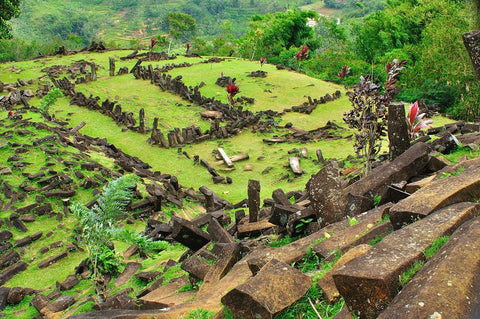Gunung Padang 🌳

Known as the largest megalithic site in Southeast Asia, Gunung Padang , located in Indonesia, never ceases to fascinate archeology enthusiasts and question researchers. Indeed, a few years ago, a team of researchers and scientists led by Danny Hilman Natawidjaja (senior scientist of the Indonesian Institute of Sciences), reportedly revealed the existence of what appears to be, according to their findings, the oldest terraced pyramid in the world.
What is this megalithic site located in Indonesia? And would it then hide, as this team of researchers declared, the oldest pyramid in the world?
What is this megalithic site located in Indonesia? And would it then hide, as this team of researchers declared, the oldest pyramid in the world?

Gunung Padang (literally the “Mountain for God”, or “Mountain of Light), is a megalithic site located in Indonesia which was discovered at the beginning of the 20th century. A place designated as sacred and venerated by the local inhabitants which shelters rows of walls, and columns of natural stones, but whose origin of their arrangements remains unclear.
A rather mysterious site located 885 meters above sea level on what archaeologists had previously thought to be a verdant hill.
However, archaeologists are not so sure today.
Indeed, Danny Hilman Natawidjaja and his team (which I mentioned earlier in the introduction), were quite intrigued by the topography of this hill (little eroded and rather “young”) compared to the surrounding topography (very eroded). A finding that led them to wonder if this hill and this megalithic site would not hide something else.
In order to find out for sure, they decided to explore under the ground of this hill using various techniques such as X-ray tomography , 3D imaging , and also carbon 14 dating .
And their findings were amazing to say the least.
A rather mysterious site located 885 meters above sea level on what archaeologists had previously thought to be a verdant hill.
However, archaeologists are not so sure today.
Indeed, Danny Hilman Natawidjaja and his team (which I mentioned earlier in the introduction), were quite intrigued by the topography of this hill (little eroded and rather “young”) compared to the surrounding topography (very eroded). A finding that led them to wonder if this hill and this megalithic site would not hide something else.
In order to find out for sure, they decided to explore under the ground of this hill using various techniques such as X-ray tomography , 3D imaging , and also carbon 14 dating .
And their findings were amazing to say the least.

The majority of this hill would be artificial and would have been created by Man. Several layers below the surface, and extending over a total area of no less than 15 hectares, have indeed been discovered. 3 layers each representing a distinct period and dating back several thousand years.
The first layer (Layer 2 of the image) dates back to between 3000 and 3500 years BC. JC , the second (Layer 3) between 7500 and 8300 years BC. JC , and the third layer (Layer 4) located 15 meters deep, would date it from more than 9000 years BC. JC !
In addition, according to the study, several underground chambers also exist below the surface.
A green hill and a megalithic site which would therefore in fact house, if the results of this team and their study are proven, the oldest terraced pyramid in the world.
Nevertheless, these findings remain for the moment very controversial. Indeed, the research and methods used have not convinced everyone and the results of carbon 14 dating have been called into question.
And unfortunately, currently, we don't really have any additional information on whether or not this study is true and on this site. So the mystery remains intact for the moment.
The first layer (Layer 2 of the image) dates back to between 3000 and 3500 years BC. JC , the second (Layer 3) between 7500 and 8300 years BC. JC , and the third layer (Layer 4) located 15 meters deep, would date it from more than 9000 years BC. JC !
In addition, according to the study, several underground chambers also exist below the surface.
A green hill and a megalithic site which would therefore in fact house, if the results of this team and their study are proven, the oldest terraced pyramid in the world.
Nevertheless, these findings remain for the moment very controversial. Indeed, the research and methods used have not convinced everyone and the results of carbon 14 dating have been called into question.
And unfortunately, currently, we don't really have any additional information on whether or not this study is true and on this site. So the mystery remains intact for the moment.

